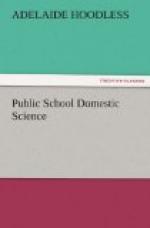BAKED FISH.
1 cup cracker or bread crumbs. 1 ssp. salt. 1 tsp. chopped onion. 1 tsp. chopped parsley. 1 ssp. pepper. 1/4 cup melted butter or dripping.
Clean, wipe and dry the fish, rub with salt; fill with stuffing and sew or tie carefully. Rub all over with butter (or dripping), salt and pepper, dredge with flour, put it into a hot oven; baste when the flour is brown, and often afterwards. Remove carefully from the pan and place upon a hot platter.
SCALLOPED FISH.
Pick over carefully any remnants of cold boiled or baked fish, put into a shallow dish in alternate layers with bread crumbs and cream sauce. Cover with crumbs and bake till brown.
SALT FISH BALLS.
1 cup salt fish. 1 tsp. butter. 1/4 ssp. pepper. 1 pint potatoes. 1 egg, well beaten. More salt if needed.
Wash the fish, pick in pieces and free from bones. Pare the potatoes and cut in quarters. Put the potatoes and fish in a stew-pan and cover with boiling water. Boil until the potatoes are tender. Drain off all the water; mash and beat the fish and potatoes till very light. Add the butter and pepper, and when slightly cooled add the egg. Lift in a tbsp. and drop into smoking hot fat 1 minute, drain on brown paper; they may be formed into balls and browned in a very hot oven.
* * * * *
MEAT.
(See Analysis, Chap. V.)
As meat is composed of several substances, fibrine, albumen, gelatin, fat and the juices, it is necessary to understand the various methods of cooking in order to secure the best results. Meat has its season as well as many other foods. Pork is better in autumn and winter; veal in the spring and summer; fowl in autumn and winter; lamb in the summer and autumn; mutton and beef may be used any time. Meat should not be allowed to remain in the paper in which it comes from market, as it absorbs the juices and injures the flavor. Wipe all over with a clean wet cloth. Examine carefully, remove any tainted or unclean portions and keep in a clean, cool place until required. Good beef should be a bright red color, well mixed with fat, and a layer of fat on the outside; the suet should be dry and crumble easily. (See meat diagrams for different cuts.) Mutton should have an abundance of clear, white fat, the flesh fine grained and a bright red color. The fat of veal should be clear and white, the lean pink, and should always be thoroughly cooked. Pork is more indigestible when fresh than when cured, as in bacon and ham. Fresh pork should be firm, the fat white, the lean a pale red.




